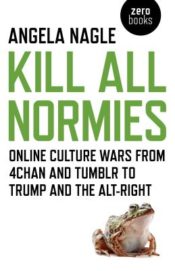 Angela Nagle
Angela Nagle
Zero Books ($16.95)
by Alex Kies
The rise of President Trump and right-wing populism worldwide was preceded and normalized by a far-right social media movement. Sites such as 4chan and reddit fostered online right-wing communities that spilled out into internet journalism, Facebook and Twitter, and ultimately the White House. In her book Kill All Normies, Irish journalist Angela Nagle elucidates the circumstances that fomented this ideology.
Nagle posits that the Obama presidency’s veneer of reasoned sincerity led to the disingenuous clicktivism of the KONY 2012 movement and the social media vilification of the Cincinnati Zoo in the wake of their euthanizing Harambe the gorilla. These trends’ self-importance and intolerance of dissent led to a good deal of disillusionment of youth on the left and the right. Gamer groups, various white nationalist and Christian conservative groups, and the remnants of the pick-up artist community congealed into a loosely affiliated, predominantly male movement referred to as the Alt-Right.
The Alt-Right is anti-authoritarian, decentralized, and often anonymous, although it has many (frequently at odds) figureheads. It follows, then, that contradictory ideologies co-exist beneath the same umbrella. Richard Spencer decries homosexuality and drug use as symptoms of Western decline, whereas both are celebrated by Milo Yiannopolis. Nagle posits that the greatest uniting force is “a bursting forth of anti-PC cultural politics through the culture wars of recent years.”
The mainstreaming of Black Lives Matter, safe spaces, transgender bathroom rights, etc. saw transgression becoming the project of retrograde racial and gender politics. Whereas once Prince’s lyrics and Dead Kennedys’ album art were the matter of Congressional inquiry, it is now edgier to release a female game designer’s home address or liken Leslie Jones to a gorilla. Indeed, Nagle argues that the Alt-Right has co-opted liberalism’s transgressive rhetoric and aesthetic. The difference is that the status quo now is more socially liberal than it was in the 1950s and ’60s. The core contradiction of Alt-Right ideology is that its strategies, because they are co-opted from and practiced in an environment of social liberalism, require liberalism to exist. As Nagle puts it, “Trump, rightist 4chan and the alt-right all represent a pretty dramatic departure from the kind of churchgoing, upstanding, button-down, family values conservativism that we usually associate with the term in Anglo-American public and political life.”
While she doesn’t quite make clear how the real-world consequences of this online discourse—especially the election of Donald Trump—were precipitated by the online hate-pit, Nagle’s analysis is trenchant and timely. What makes Kill All Normies such an insightful book is the author’s insistence on the culpability of the left in creating the vacuum in which the Alt-Right expanded. As liberal college campuses and private businesses instituted policies of gender-neutral bathrooms, safe spaces, and trigger warnings, they ironically made speech and thought less free through call-out culture. Nagle’s caution that the left’s stagnant ideas, pedantry, and infighting have made it the weaker party of the two should surely lead those who want change to reflect on their methods.
